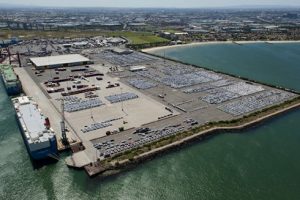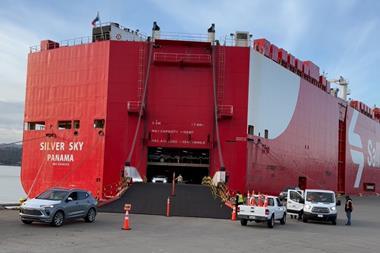 Phase one of Australia’s largest ro-ro and automotive terminal has just opened at Webb Dock West, Melbourne. The Melbourne international ro-ro and automotive terminal (MIRRAT) has been under construction for the last 18 months and includes a new 185,000 sq.m facility north of the current Webb Dock West car terminal.
Phase one of Australia’s largest ro-ro and automotive terminal has just opened at Webb Dock West, Melbourne. The Melbourne international ro-ro and automotive terminal (MIRRAT) has been under construction for the last 18 months and includes a new 185,000 sq.m facility north of the current Webb Dock West car terminal.
A second phase involving expansion of the current automotive terminal at the south end of Webb Dock West is due to start operating in January 2018.
Wallenius Wilhelmsen Logistics (WWL) will operate both terminals through its subsidiary MIRRAT after winning the bid to design, construct and operate the new terminal in 2014. Expansion of the automotive facility at Webb Dock, which is being entirely funded by the Port of Melbourne Corporation, will cost some A$400m ($303m) and is part of a bigger A$1.6 billion ($1.21 billion) development project at Australia’s largest port.
MIRRAT hopes to achieve a ‘5 Star’ Green Star rating from the Green Building Council of Australia for the new terminal and is looking to achieve an ‘excellent’ rating for its overall construction from the Infrastructure Council of Australia (ISCA). It has used more than 200,000 tonnes of recycled concrete, brick and glass in its construction and also installed LED lighting across the facility, which is expected to keep energy usage around 30% lower than it would otherwise have been.
The terminal design includes 4,800 automotive laydown bays, 20,000 sq.m of heavy-duty hardstanding, two vehicle washing bays, a 120-tonne gantry crane and dedicated inspection zones.
The second phase of development will see the existing terminal expanded to encompass three vessel wharfs and an additional laydown area, enabling it to handle 1m units annually. It will also include an 8,000 sq.m enclosed cargo storage area, a maintenance area and truck parking facilities. A vehicle appointment system will ensure good traffic flow in and out of the facility, as well as minimising the impact on surrounding road infrastructure.
Commenting on the completion of phase one, Paul Hand, managing director of MIRRAT, said, “This is an exciting time for all users of our facility and the team at MIRRAT are proud of all the achievements to date. We are ready to open this world-class terminal to help connect Melbourne to the rest of the global market.”
Jed Smith, head of commercial and stakeholder management at MIRRAT, told Automotive Logistics that after January 2018, the site would handle 100% of automotive volumes in Victoria – approximately 27% of the total Australian market. “The facility has been designed for a throughput of 1m units per year, which will be sufficient capacity based on the long-term modelling that has been conducted,” he added.
“A lot of time has been spent considering operational workflows, customer requirements and safety,” added Smith. “The end result is a facility that offers operational flexibility and handling efficiencies. The market will see benefits through smarter solutions, which will lead to better quality and visibility while cutting lead times and, ultimately, cost.
“The precinct [Webb Dock] in which MIRRAT is located is also home to PDI [pre-delivery inspection] operators who have gated access to the MIRRAT terminal operational area, allowing for ease of cargo movement across facility fence lines and along the supply chain. This co-location will benefit the auto market participants in Melbourne and greater Victoria by cutting the need for truck movements to offsite processing centres,” said Smith.
“Looking at the bigger picture, MIRRAT is the final piece of the auto market consolidation within the Port of Melbourne,” he concluded.
For more on finished vehicle developments in Australia, click here.



































